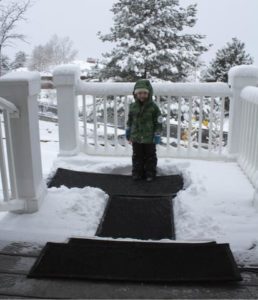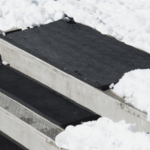Icy Slips and Falls
On January 4, 2017, Doctors in Germany prescribed a strategy to prevent slipping on ice: walk like a penguin. Imagine all your employees waddling back and forth like a rookery of penguins! This is not exactly what the German trauma surgeons meant. The technique involves leaning forward so that a person’s center of gravity is on the front leg rather than divided evenly between both legs. “When humans walk normally, body weight is split almost evenly over both legs, which the surgeons say increases the risk of a person losing their balance and falling on slippery surfaces.” It’s a comical visual; however, slipping on ice is a serious workplace concern during icy and cold conditions.
Slip and Fall Statistics
- Falls account for over 8 million hospital emergency room visits, representing the leading cause of visits (21.3%). Slips and falls account for over 1 million visits, or 12% of total falls.
- Fall fatalities are nearly equally divided between men and women. However, more women will experience a slip-and-fall accident. According to the Bureau of Labor Statistics, falls accounted for 5% of the job-related fatalities for women compared to 11% for men.
- Fractures are the most serious consequences of falls and occur in 5% of all people who fall.
- Slips and falls do not constitute a primary cause of fatal occupational injuries, but represent the primary cause of lost days from work.
- Slips and falls are the leading cause of workers’ compensation claims and are the leading cause of occupational injury for people aged 55 years and older.
5 Strategies for Slip and Fall Prevention
These strategies will work for individuals as well as for employers.
1. Keep Areas Clean and Uncluttered
Create a routine of good housekeeping. Whether the work area is indoors or outdoors, establishing a daily ritual of tidying up before shutting down will reduce slip hazards and other opportunities for injury. Return tools and equipment to their proper storage location. Throw away debris and garbage. Avoid stringing cords, cables or air hoses across hallways or in any designated walkway. Encourage safe work practices, such as closing file cabinet drawers after use and picking up loose items from the floor. Clean floors and walkways. If an organization’s facilities are clean and well organized, that is a good indication that your safety program is effective as well.
To make this a successful practice for your organization, do the following:
- Implement a program — Establish housekeeping procedures as a part of the daily routine.
- Plan ahead — Know what needs to be done, who’s going to do it and what the particular work area should look like when you are done.
- Assign responsibilities — It may be necessary to assign a specific person or group of workers to clean up, although personal responsibility for cleaning up after oneself is preferred.
2. Reduce Wet or Slippery Surfaces
Traffic areas account for a large portion of injuries reported by state agencies. These areas include:
- Parking lots
- Sidewalks (or lack thereof)
- Food preparation areas
- Shower stalls in residential dorms
- Floors in general
Cold and wet outdoor surfaces change considerably when weather conditions change. When it is messy outside, the mess has the tendency to make its way inside. Adding traction and slip-prevention to outdoor areas will improve traffic areas throughout your entire location. These strategies will help to prevent slipping on ice.
- Keep parking lots and sidewalks clean and in good repair.
- When snow and ice are present, remove or treat these elements to prevent slipping on ice. If the area cannot be addressed immediately, you may need to suspend the use. Watch weather and be prepared for these occurrences.
- Use adhesive striping material or anti-skid paint whenever possible.
Indoor control measures can help reduce the incidence of slips and falls:
- Use moisture-absorbent rugs/mats with anti-slip backings and beveled edges at entrances.
- Use “Wet Floor” signs as needed.
- Apply anti-skid adhesive tape in troublesome areas.
- Remove and clean spills immediately. Everyone should know the procedure for addressing spills in the workplace.
3. Maintain Proper Lighting
Poor lighting is associated with an increase in accidents.
- Keep work areas well lit and clean.
- Use proper illumination in walkways, staircases, ramps, hallways, basements, construction areas and dock areas.
- Upon entering a darkened room, always turn on the light first, and keep areas around light switches clear and accessible.
- Keep poorly lit walkways clear of clutter and obstructions.
- Repair fixtures, switches and cords immediately if they malfunction.
4. Wear Proper Footwear
Shoes play a big part in preventing falls and are a critical component of PPE. The slickness of the soles and the type of heels need to be evaluated to avoid slips, trips and falls. Tie shoelaces correctly. Whenever a fall-related injury is investigated, the footwear should be evaluated to see if it contributed to the incident. Train employees to wear footwear appropriate for their duties.
5. Control Individual Behavior
Create an atmosphere/culture of behavior-based safety. It’s human nature to let our guard down and to be distracted by random thoughts or multi-tasking. Rushing, walking too fast, or running, will increases the chances of a slip, trip or fall. Taking shortcuts, not watching where one is going, using a cell phone, carrying materials which obstruct vision, wearing sunglasses in low-light areas, not using designated walkways and speed are common factors in many on-the-job injuries. This may be the most difficult, but it is the most important part of your safety program. Train employees to clearly understand that it is up to them to stay alert and pay attention and to look out for fellow employees.
Snow Shoveling
While snow shoveling can be good exercise, it can also be dangerous for the optimistic shoveler who takes on more than he/she should. Shoveling snow is extremely strenuous, especially for those individuals who do not engage in regular cardiovascular activity. According to the Cleveland Clinic, approximately 11,000 people seek shoveling-related hospital treatment each year for injuries (93%) or cardiac issues (7%). Here are some tips from the National Safety Council for safe snow shoveling:
Individuals over the age of 40 and/or those who are relatively inactive, should be especially careful.
- If you have a history of heart trouble, do not shovel without a doctor’s permission.
- Avoid shoveling after eating or while smoking.
- Take it slow! Shoveling (like lifting weights) can raise your heart rate and blood pressure dramatically; so pace yourself. Stretch out and warm up to prepare your body before taking on the task.
- Shovel only fresh snow. Freshly fallen, powdery snow is easier to shovel than the wet, packed-down old snow.
- Push the snow as you shovel. It’s easier on your back than lifting the snow out of the way.
- Don’t pick up too much at once. Use a small shovel, or fill only one-fourth or one- half of a large one.
- Use proper technique. Lift with your legs bent, not your back. Keep your back straight. By bending and “sitting” into the movement, you’ll keep your spine upright and less stressed. The strongest muscles in your body (your shoulders, torso and thighs) can do the work for you.
- Do not work to the point of exhaustion. If you run out of breath, take a break. If you feel tightness in your chest, stop immediately.
POWERBLANKET CREATED SUMMERSTEP
Removing ice and snow regularly to prevent slipping on ice can be a full-time job depending on the weather. To save time, energy, and your employees health, use Summerstep industrial snow melting mats and residential snow melting mats to keep the walkways on your construction site clear and avoid snow shoveling.
Summerstep Snow Melting Mats
- Prevent slipping on ice and falls
- Protect personnel from winter weather conditions and keep stairs, doorways, walkways, and ramps free from snow and ice
- More convenient than shoveling snow
- Avoid health risks associated with snow shoveling
- More effective for snow and ice melting than harsh chemicals (less damaging to the environment, reusable, won’t damage concrete or other flooring surfaces)
- Will melt approximately 2 inches of snow per hour when operating
- 40 Watts/Sq ft heated area
- The ONLY snow melting mat product made in the USA
Sources
“Quick Facts.” National Floor Safety Institute. 6 January 2017. https://nfsi.org/nfsi-research/quick-facts/
“Snow Shoveling”. National Safety Council. 6 January 2017. www.nsc.org/NSCDocuments_Corporate/SafetyObservancesDocuments/Snow-Shoveling.pdf
“Snow Shoveling—A Real Risk for Heart Attack”. Cleveland Clinic. 6 January 2017. https://health.clevelandclinic.org/2015/02/snow-shoveling-a-real-risk-for-heart-attack/
“Walk like a penguin to avoid slipping on ice, German doctors advise”. Reuters in Berlin. 6 January 2017. www.theguardian.com/world/2017/jan/04/penguin-walk-german-doctors-advice-slipping-icy-paths
Keep your steps, doorways and walkways safe this winter with Summerstep.





